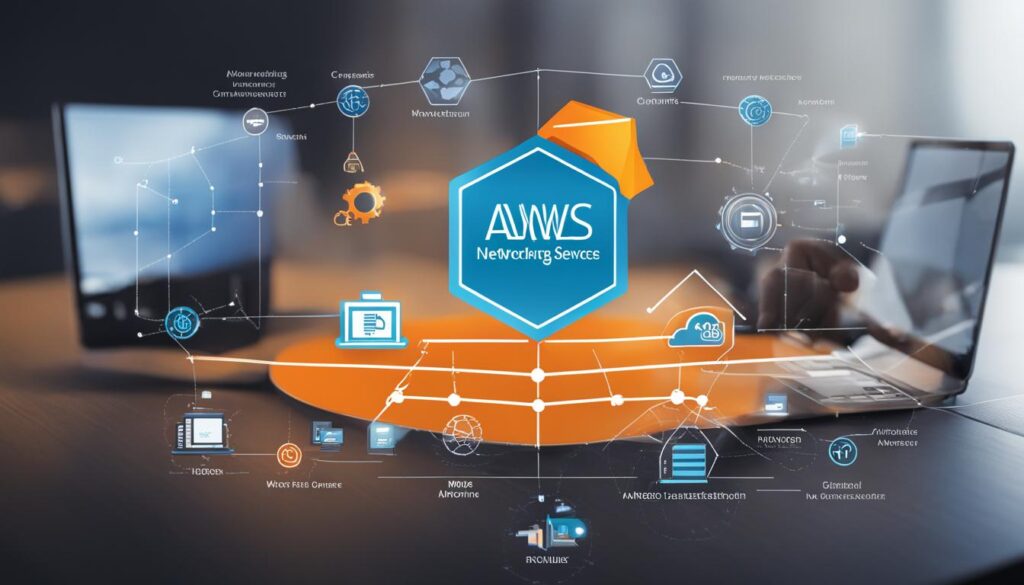Networking is a fundamental concept in information technology that plays a crucial role in connecting and exchanging data between devices in a computer network. In simple terms, networking refers to the practice of establishing a communication channel between nodes to facilitate data transfer and resource sharing.
In the context of information technology, networking involves the use of protocols and infrastructure to enable devices to work together seamlessly. It encompasses both wired and wireless networks, with wired networks utilizing physical mediums like cables, while wireless networks use radio waves.
The components of networking include the physical infrastructure, such as switches and routers, as well as the software and protocols that govern communication. Together, they enable the smooth transmission and exchange of information.
- Networking is the practice of connecting devices in a computer network to exchange data.
- It involves the use of protocols and infrastructure for seamless communication.
- Networking can be wired or wireless, depending on the medium used.
- Components of networking include physical infrastructure, software, and protocols.
- The goal of networking is to enable efficient data transfer and resource sharing.
Contents
- 1 The Importance of Networking in IT
- 2 Types of Networking in IT
- 3 Enterprise Computer Networks
- 4 AWS Networking Services
- 5 Using AWS Networking Services
- 6 Conclusion
- 7 FAQ
- 7.1 What does networking mean in information technology?
- 7.2 What is the definition of networking in IT?
- 7.3 What is the importance of networking in IT?
- 7.4 What are the benefits of networking in IT?
- 7.5 What are the types of networking in IT?
- 7.6 What are the networking concepts in IT?
- 7.7 What are the networking basics in IT?
- 7.8 What are the types of enterprise computer networks?
- 7.9 What are AWS networking services?
- 7.10 How can organizations use AWS networking services?
- 7.11 What is the role of networking in information technology?
- 8 Source Links
The Importance of Networking in IT
Networking plays a crucial role in information technology by enabling devices and endpoints to communicate, share resources, and access services. It serves as the backbone of modern business operations, providing the foundation for seamless connectivity and efficient data exchange.
One of the key benefits of networking in IT is the ability to transmit and exchange data. Through networks, data can be sent from one device to another, allowing for collaboration, file sharing, and real-time updates. This facilitates efficient workflows and enables teams to work together seamlessly, regardless of their physical location.
Networking also supports essential communication technologies, such as Voice over Internet Protocol (VoIP), which allows for voice and video calls over the internet. With networking, organizations can implement cost-effective and reliable communication solutions that enhance productivity and enable effective remote collaboration.
Moreover, networking is instrumental in enabling various services that we rely on daily. Email, online commerce, social networks, and cloud-based applications all rely on networking infrastructure to function properly. These services have become integral parts of both personal and professional lives, and networking ensures their availability and accessibility.
“Networking is the cornerstone of modern businesses, enabling efficient communication, collaboration, and access to vital services.”
Flexibility and scalability are additional advantages of networking in IT. Networks can be easily expanded to accommodate growing demands, allowing businesses to scale their operations without costly investments in new infrastructure. The ability to adapt and scale quickly is vital in today’s rapidly evolving technological landscape.
Ensuring the security of sensitive information is paramount in IT, and networking plays a significant role in this area. Features like encryption, firewalls, and access controls help safeguard data and protect networks from unauthorized access. Networking professionals continually update and implement security measures to mitigate vulnerabilities and ensure the integrity of data and systems.
High-speed performance is another crucial benefit of networking in IT. With advancements in network technologies, organizations can leverage faster internet connectivity and network speeds, enabling efficient data transfer, reduced latency, and enhanced user experiences.
Benefits of Networking in IT:
- Improved collaboration and file sharing
- Enhanced communication with VoIP
- Availability of essential services like email and online commerce
- Flexibility and scalability for business growth
- Enhanced security measures to protect sensitive data
- High-speed performance for efficient data transfer
By understanding the importance and benefits of networking in IT, organizations can harness its power to drive innovation, streamline operations, and stay ahead in today’s digital landscape.
Types of Networking in IT
In information technology, there are various types of networking that serve different purposes. Understanding these networking concepts is essential for building and managing effective computer networks. Let’s explore some of the key types of networking in IT:
1. Local Area Network (LAN)
A Local Area Network (LAN) is a network that connects devices within a limited geographic area, such as an office building or a school campus. It enables users to share resources like files, printers, and applications within the network. LANs are typically fast and secure, making them ideal for organizations that require high-speed internal communication.
2. Wide Area Network (WAN)
A Wide Area Network (WAN) spans a large geographic area and connects multiple local networks or LANs. It allows for the interconnection of computers and devices over long distances, often utilizing leased lines or public internet connections. WANs are commonly used by businesses to connect their branch offices, enabling seamless communication and data sharing across different locations.
3. Wireless Networks
Wireless networks use radio waves to connect devices, eliminating the need for physical cables. This type of network enables users to connect to the internet and share resources without being physically tethered to a specific location. Wireless networks are commonly found in homes, offices, public spaces, and even entire cities, providing flexibility and convenience for users.
4. Metropolitan Area Network (MAN)
A Metropolitan Area Network (MAN) is a network that spans a larger geographic area than a LAN but smaller than a WAN. It covers a city or a metropolitan region, allowing organizations to connect multiple sites within the same area. MANs often utilize high-speed fiber optic cables for efficient data transmission and are commonly used by educational institutions, government agencies, and large corporations.
5. Virtual Private Network (VPN)
A Virtual Private Network (VPN) provides a secure connection over a public network, such as the internet. It enables users to access resources and services as if they were connected to the same local network, even when they are physically remote. VPNs are widely used by individuals and organizations to establish secure connections, protect sensitive data, and ensure privacy.

These are just a few examples of the types of networking in IT. Each type serves a specific purpose and offers unique benefits. By understanding these networking concepts, you can design and implement the most suitable network infrastructure for your organization’s needs.
Comparison of Networking Types
| Networking Type | Geographic Scope | Connectivity Medium | Common Use Cases |
|---|---|---|---|
| LAN | Localized | Ethernet, Wi-Fi | Office buildings, schools |
| WAN | Wide | Leased lines, MPLS, internet | Connecting branch offices, global communication |
| Wireless | Localized | Wi-Fi, cellular | Homes, offices, public spaces |
| MAN | Metropolitan | Fiber optic cables | City-wide connectivity |
| VPN | Remote | Internet | Remote access, secure communication |
This table provides a quick comparison of the various networking types discussed above, outlining their geographic scope, connectivity medium, and common use cases.
Enterprise Computer Networks
In the context of enterprise IT, understanding the different types of computer networks is essential. These networks serve as the backbone of an organization’s digital infrastructure, facilitating communication, data sharing, and resource access.
Let’s take a closer look at the basic types of enterprise computer networks:
Local Area Network (LAN)
A Local Area Network (LAN) is a network that connects devices within a limited geographical area, such as an office, school, or building. LANs typically use Ethernet cables or Wi-Fi connections to enable communication between devices in close proximity. They offer high-speed data transfer and are commonly used for sharing resources like printers, files, and internet access.
Wide Area Network (WAN)
A Wide Area Network (WAN) spans across larger distances, connecting multiple LANs or other networks over a wide geographic area. WANs utilize different technologies like leased lines, satellite links, or internet connections to establish connectivity between locations. They enable organizations to connect geographically dispersed offices, branches, or data centers, providing secure and reliable communication.
Virtual Private Network (VPN)
A Virtual Private Network (VPN) is a secure network connection that allows remote users or branch offices to access the organization’s internal network over the internet. VPNs use encryption and tunneling protocols to create a secure “virtual” connection, ensuring data confidentiality and integrity. They provide a cost-effective solution for remote access and allow users to connect to the corporate network as if they were physically present in the office.
Cloud Network
Cloud networks involve utilizing cloud computing infrastructure to build scalable and flexible network architectures. Organizations can leverage cloud service providers like Amazon Web Services (AWS) or Microsoft Azure to deploy virtual networks, storage, and applications. Cloud networks offer on-demand scalability, resilience, and cost-effectiveness, enabling businesses to adapt to changing needs and rapidly deploy new services.
Understanding these different types of enterprise computer networks is crucial for organizations to design and implement a network infrastructure that aligns with their specific requirements.

Now, let’s delve deeper into AWS networking services and how they can benefit enterprises in the next section.
AWS Networking Services
When it comes to computer networking services, Amazon Web Services (AWS) is a leader in the industry. AWS offers a comprehensive range of networking services that are designed to provide enterprises with reliable and secure network infrastructure.
One of the key networking services offered by AWS is Amazon Virtual Private Cloud (VPC). VPC allows you to create a virtual network in the AWS cloud, complete with subnets, routing tables, and security groups. It enables you to have complete control over your network environment while providing seamless connectivity with other AWS services.
Another essential networking service provided by AWS is AWS Direct Connect. This service allows you to establish a dedicated network connection between your on-premises data center and the AWS cloud. With AWS Direct Connect, you can achieve low-latency and high-bandwidth connections, ensuring a fast and reliable network experience.
AWS also offers networking services such as Elastic Load Balancing, which distributes incoming traffic across multiple AWS resources to improve scalability and fault tolerance. Additionally, AWS Elastic Beanstalk provides an easy way to deploy and manage your applications while automatically handling the capacity provisioning, load balancing, and application health monitoring.
Key Features of AWS Networking Services:
- Highly scalable and reliable network infrastructure
- Seamless integration with other AWS services
- Flexible and customizable network configurations
- Enhanced security and compliance
- Low-latency and high-bandwidth connections

With AWS networking services, you can easily build and manage your network infrastructure in a flexible, scalable, and secure manner. Whether you need to establish private networks, enable connectivity between multiple regions, or distribute traffic across your resources, AWS has you covered.
Using AWS Networking Services
To harness the power of AWS networking services, organizations can follow these steps:
- Plan your network architecture: Before diving into AWS networking services, it’s crucial to have a clear plan in place. Define your network requirements, including the number of virtual private clouds (VPCs) you need, the IP address range, and the subnets for your resources.
- Create and configure VPC: Use the AWS Management Console or the AWS Command Line Interface (CLI) to create a VPC. Configure your VPC’s IP address range, subnet range, security groups, and route tables. This step establishes the foundation of your AWS network infrastructure.
- Connect VPCs: If your organization requires multiple VPCs, use the AWS Transit Gateway or VPC Peering to establish connectivity between them. This allows you to securely communicate and share resources across different VPCs within your AWS environment.
- Implement networking components: Take advantage of AWS networking services such as Elastic Load Balancing, Amazon Route 53, and AWS PrivateLink to enhance the performance, scalability, and security of your applications running in AWS. These services offer features like load balancing, DNS management, and private network connectivity.
- Set up connectivity to on-premises networks: If you have on-premises resources, establish a secure connection between your AWS VPCs and your local network. AWS provides options like AWS Site-to-Site VPN and AWS Direct Connect for securely extending your network infrastructure into the cloud.
- Monitor and optimize network performance: Regularly monitor your network using AWS CloudWatch and VPC Flow Logs. These tools provide insights into network traffic, help identify potential bottlenecks or security threats, and allow you to optimize your network’s performance.
By following these steps, organizations can effectively leverage AWS networking services to create robust and secure network architectures in the cloud.
“Using AWS networking services allows organizations to build scalable and cost-effective network infrastructures in the cloud, enabling seamless communication and resource sharing.”
Sample Table: AWS Networking Services Comparison
| AWS Networking Service | Key Features |
|---|---|
| Elastic Load Balancing | Automatically distributes incoming traffic across multiple Amazon EC2 instances to improve application availability and fault tolerance. |
| Amazon Route 53 | Highly scalable and reliable DNS web service that routes traffic efficiently to AWS resources and external endpoints. |
| AWS PrivateLink | Securely access services hosted on AWS privately, without using public IPs, by utilizing private connections. |
| AWS Site-to-Site VPN | Establish a secure and encrypted connection between your AWS VPC and your on-premises network, extending your network infrastructure. |
| AWS Direct Connect | Create a dedicated network connection from your on-premises data center to AWS, bypassing the public internet for improved performance and security. |

Conclusion
Networking is a fundamental aspect of information technology that plays a critical role in enabling devices to connect, communicate, and share resources. It encompasses various types of networks, such as Local Area Networks (LANs), Wide Area Networks (WANs), and cloud networks, which are essential for facilitating seamless data transmission and supporting vital services like Voice over Internet Protocol (VoIP), email, and online commerce. The architecture of computer networks is a complex system that involves both physical infrastructure, such as switches and routers, as well as software and protocols that ensure effective communication.
One notable provider of comprehensive networking solutions for enterprises is Amazon Web Services (AWS). AWS offers a range of networking services that prioritize network security, availability, and performance. By leveraging these services, organizations can build robust computer network architectures that ensure efficient data transfer and support the growing demands of their business operations.
Understanding and utilizing networking concepts and technologies is crucial for organizations to effectively leverage the power of information technology. By embracing networking principles, businesses can create highly connected environments that foster collaboration, streamline processes, and enhance overall productivity. With an optimized computer network architecture, organizations can meet their communication and data-sharing needs while staying competitive in the rapidly evolving technology landscape.
FAQ
What does networking mean in information technology?
Networking in information technology refers to the practice of connecting and exchanging data between nodes in a computer network. It involves the use of protocols and infrastructure to facilitate communication and data sharing between devices.
What is the definition of networking in IT?
In IT, networking is the process of creating and maintaining a connection between devices in a computer network. It enables communication, data sharing, and access to services through the use of protocols and infrastructure.
What is the importance of networking in IT?
Networking plays a crucial role in IT by enabling devices and endpoints to communicate, share resources, and access services. It improves collaboration, increases efficiency, enhances security, and provides high-speed performance.
What are the benefits of networking in IT?
The benefits of networking in IT include improved collaboration, increased efficiency, enhanced security with features like encryption, and high-speed performance. It also allows for the transmission and exchange of data and supports communication technologies and services.
What are the types of networking in IT?
In IT, networking can be categorized into wired and wireless types. Wired networks use physical mediums like cables, while wireless networks use radio waves. Other types include local area networks (LANs), wide area networks (WANs), and cloud networks.
What are the networking concepts in IT?
Networking concepts in IT include the physical network infrastructure such as switches and routers, as well as the software and protocols that enable communication. These concepts encompass areas like network topology, IP addressing, network security, and network management.
What are the networking basics in IT?
Networking basics in IT involve understanding concepts like network protocols, network addressing, network devices, and network troubleshooting. It also includes knowledge of networking standards and technologies such as Ethernet, TCP/IP, and DNS.
What are the types of enterprise computer networks?
In the context of enterprise IT, there are several types of computer networks. These include local area networks (LANs) that connect devices within a single location, wide area networks (WANs) that connect geographically dispersed locations, and virtual private networks (VPNs) that provide secure remote access to a private network.
What are AWS networking services?
Amazon Web Services (AWS) provides a range of networking services for enterprises. These services include AWS Virtual Private Cloud (VPC) for creating isolated virtual networks, AWS Direct Connect for establishing dedicated network connections to AWS, and AWS Route 53 for domain name system (DNS) management.
How can organizations use AWS networking services?
To utilize AWS networking services, organizations can create virtual private networks (VPNs) within the AWS Virtual Private Cloud (VPC), establish dedicated network connections using AWS Direct Connect, and manage their domain name system (DNS) with AWS Route 53. These services provide network security, availability, and performance for enterprise IT infrastructure.
What is the role of networking in information technology?
Networking is a fundamental aspect of information technology that enables devices to connect, communicate, and share resources. It encompasses various types of networks, such as LANs, WANs, and cloud networks. Networking allows for the efficient transmission of data and supports services like VoIP, email, and online commerce.




